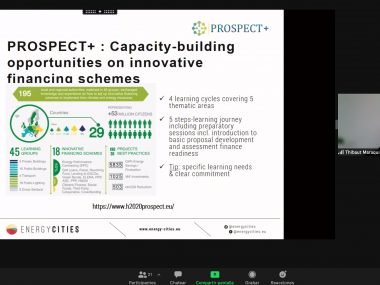Vilawatt UTM Learning Webinars - Sharing experiences and learning in order to build future Investment Plan
Edited on
11 January 2022The Vilawatt URBACT transfer process includes five learning webinars, the mission of which is for the partner cities to deepen their knowledge of the five pillars that make up the Vilawatt Innovative Practice, and thus be able to better address the task of building the future Investment Plan of each city.

These sessions are the opportunity to learn from experts about real experiences and case studies on the following subjects: retrofitting, energy communities and links with the project governance (the public-private-citizens partnership), energy pooling, citizens engagement in energy efficiency strategies, and the incentives to generate project buy in.
The first of the webinars, held on 1 October 2021, focused on the topic of retrofitting and allowed the partner cities to get closer to different inspiring projects in this field.
Eva Geröhazi and Hannah Szemzö from the Hungary Metropolitan Research Institute presented the ComAct (Community Actions) project being developed in Budapest, which investigates how private building renovation in the city impacts on the fight against energy poverty. Their experience tells us that, at least in Hungary, it is more efficient to invest in the renovation of single-family houses than multi-family houses, as they have found that the cost of renovation in relation to energy savings is much more optimal. In addition, they found that older buildings, especially public buildings built before World War II, have a higher renovation efficiency, while those built after 1990 are less cost-effective in terms of renovation value. They also highlighted the difference between renovating owned buildings and renovating rented buildings. In the first case it must be considered that the owners have to bear the costs of renovation. And in the case of rented buildings, the financial and organisational issues become more complicated, as these are often buildings where people with different profiles and economic situations live together. However, according to their experience, building rehabilitation is not a magic formula against poverty, it is usually a process with a high cost that must be assumed by the owners and that, on many occasions, has repercussions on the tenants, generating gentrification, and, although there are subsidies, the payment periods can be extremely long (from 15 to 40 years).
Hannah Szemzö concluded her speech by saying that it does not make sense to consider only the material costs of renovations in relation to energy efficiency and poverty, but that other aspects and motivations should be considered, such as the sense of public good: "Just as states invest in the school system, healthcare system, etc., not for profit, but for the long-term benefit of society."
Thibaut Maraquin from association of cities Energy Cities association in Brussels spoke about the Innovate project, a programme that brings together and integrates the main stakeholders involved in retrofitting tasks such as companies, builders, craftsmen, real estate agencies, financial institutions, consultants, energy auditors, etc., to provide a comprehensive service in 11 European territories.
He also explained how the ORFEE (Office of Renovations and Financings for Energy Efficiency) operates in France, which aims to establish a resource-sharing platform with a one-stop shop for third-party financing companies operating at regional level. These companies provide complete renovation packages, complementing public subsidies, which include both financing construction works and subsequent monitoring of the project. ORFEE gives access to long-term direct loans (25 years) that integrate the perspective of expected energy savings and the repayment capacity of the owners.
Maraquin noted that the renovation of public buildings can also benefit from this type of one-stop shop formula, as is already the case in Belgium, where there is a public procurement agency acting on behalf of the municipal authorities, with 150 beneficiary buildings.
Finally, he spoke about the Prospect+ project, a recently launched programme that explores the exchange of knowledge on innovative financing schemes through a system based on mentoring where the “students” are the local authorities.
Finally, in this first learning webinar, Arturo Zea from València Clima i Energia, explained how this public entity promoted by Valencia City Council works. The entity, which currently manages the Energy Office and the Climate Change Observatory, aims to establish links between citizens and local actors in the framework of energy culture and climate transition.
The project is performing very well, and the data speaks for itself, as Zea says, in 2020 657 individual meetings were scheduled to resolve questions related to energy issues (understanding electricity bills, consumption and savings, etc.) and they also carried out numerous collective activities to provide training for neighbourhood associations, universities and professional groups. The Valencian public entity also participates in the Horizon 2020 Programme that promotes the one-stop shop for the retrofitting of buildings, advises on the installation of photovoltaic panels, promotes the first two energy communities in the city and an educational programme to train students, teachers and family associations in energy efficiency.
After a question-and-answer session between the speakers and the participating cities, all partners engaged in a “building on learning” activity to help decide what was relevant and what could be developed in their cities.
Submitted by Miriam Martín on
